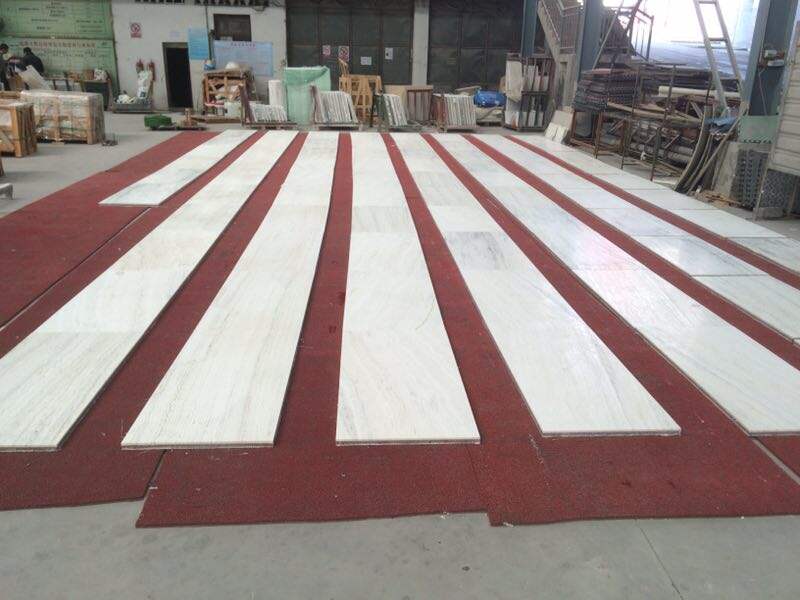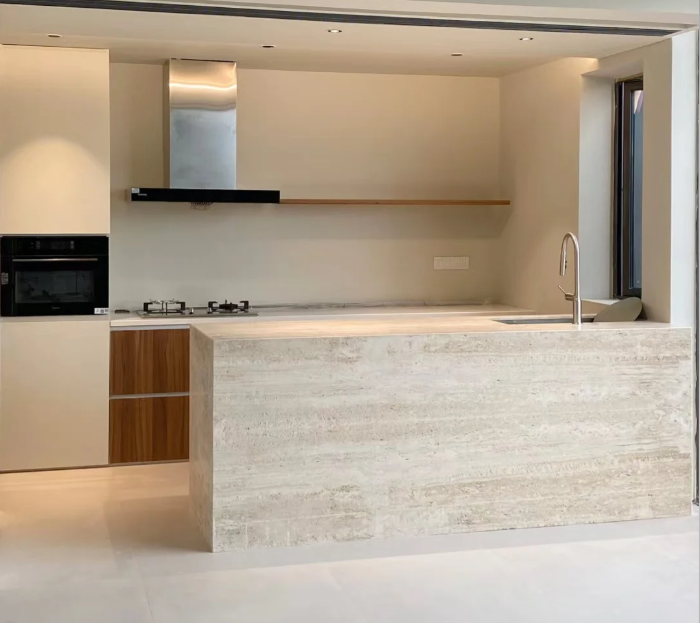Enhance Your Space with Travertine Beige Stone: A Practical Guide
Travertine Beige Stone has long been a favorite in home design, valued for its warm, earthy tones and natural beauty. This versatile natural stone adds a touch of elegance to any space, from kitchens and bathrooms to living rooms and outdoor patios. With its unique texture and neutral beige hues, Travertine Beige Stone blends seamlessly with a variety of decor styles, making it a practical choice for homeowners looking to enhance their spaces. This guide explores everything you need to know about Travertine Beige Stone, from its characteristics and uses to care tips and design ideas.
What Is Travertine Beige Stone?
Travertine is a type of natural limestone formed from mineral-rich water deposits, typically near hot springs or limestone caves. Over time, layers of calcium carbonate build up, creating a porous stone with distinctive veins and textures. Travertine Beige Stone is a popular variety known for its soft beige, cream, or light brown tones, often with subtle hints of gold, gray, or ivory in its natural patterns.
What sets Travertine Beige Stone apart is its unique texture. It features small holes and channels (called “vesicles”) formed by gas bubbles trapped during its formation. These pores give the stone a rustic, organic look that adds character to any surface. While some homeowners choose to fill these pores for a smoother finish, others embrace them for a more natural, textured appearance.
Unlike man-made materials, each piece of Travertine Beige Stone is one-of-a-kind, with variations in color and pattern that make it a truly unique addition to your home. Its natural composition also makes it durable and long-lasting, with proper care.
Key Characteristics of Travertine Beige Stone
Understanding the traits of Travertine Beige Stone helps you decide if it’s the right choice for your space. Here are its most notable characteristics:
Warm, Neutral Color Palette
Travertine Beige Stone’s soft beige tones create a warm, inviting atmosphere in any room. Its neutral color makes it easy to pair with other colors and materials, from bold accents to muted decor. Whether your style is modern, traditional, or rustic, the beige base provides a versatile backdrop that complements wood, metal, glass, and other stones.
Natural Texture and Pattern
The stone’s porous surface and subtle veining add depth and visual interest. Veins can range from thin, wispy lines to thicker, more pronounced patterns, often in shades of cream, gray, or gold. This natural texture adds a tactile element to surfaces, making them feel more organic and less “manufactured” than smooth, uniform materials.
Durability with Proper Care
Travertine Beige Stone is a relatively hard stone, but it is softer than granite or quartzite. It has a Mohs hardness rating of 3–4, meaning it can scratch or etch if not cared for properly. However, with sealing and regular maintenance, it holds up well in high-traffic areas like floors and countertops. It’s also heat-resistant, making it suitable for fireplace surrounds or kitchen backsplashes.

Porosity
One of the most important traits of Travertine Beige Stone is its porosity. The small holes and pores in the stone can absorb liquids, which means it is prone to staining if not sealed. This porosity also makes it slightly more susceptible to damage from acidic substances like lemon juice, vinegar, or coffee, which can etch the surface. Proper sealing and quick cleanup of spills are essential to keep it looking its best.
Best Uses for Travertine Beige Stone in Your Home
Travertine Beige Stone’s versatility makes it suitable for a variety of indoor and outdoor spaces. Here are the most popular ways to use it:
Flooring
Travertine Beige Stone floors add warmth and elegance to entryways, living rooms, hallways, and bathrooms. Its natural texture provides traction, making it a safe choice for areas prone to moisture, like bathrooms or kitchens (when sealed). Large-format tiles create a seamless look, while smaller tiles can be arranged in patterns like herringbone or basketweave for added style.
Countertops
In kitchens and bathrooms, Travertine Beige Stone countertops bring a natural, earthy feel. They pair beautifully with white or wood cabinets, creating a timeless look. For kitchens, a honed (matte) finish is often preferred, as it hides water spots and scratches better than a polished finish. In bathrooms, travertine vanities add a spa-like touch, especially when paired with neutral tiles and natural materials.
Backsplashes
A Travertine Beige Stone backsplash adds texture and warmth to kitchen walls, complementing countertops (whether they’re travertine or another material). Subway tiles or small mosaic pieces work well, creating a cohesive look that ties the kitchen together. The stone’s natural color also helps hide minor splatters from cooking.
Fireplace Surrounds
A Travertine Beige Stone fireplace surround becomes a focal point in living rooms or dens. Its heat resistance makes it a practical choice, and its warm tones complement the glow of a fire. A polished finish can add a sleek look, while a honed finish enhances the stone’s natural texture for a more rustic feel.
Outdoor Spaces
Travertine Beige Stone is a great choice for covered outdoor areas like patios, pool decks, or outdoor kitchens. Its natural texture provides grip, even when wet, and its neutral color blends with outdoor landscapes. When sealed properly, it resists damage from weather and UV rays, though it should be protected from harsh winters or extreme temperatures.
Accent Walls
For a bold design statement, use Travertine Beige Stone as an accent wall in dining rooms, bedrooms, or home offices. Large slabs create a dramatic backdrop, while stacked stone (smaller, irregular pieces) adds a rustic, textured look. The stone’s warm color makes the space feel cozy and inviting.
Choosing the Right Finish for Travertine Beige Stone
The finish of your Travertine Beige Stone affects both its appearance and maintenance needs. Here are the most common options:
Honed
A honed finish is matte and smooth, with a velvety texture. It enhances the stone’s natural color and hides scratches, water spots, and fingerprints better than a polished finish. This makes it a popular choice for high-traffic areas like floors and countertops. Honed Travertine Beige Stone has a more casual, organic look that works well in rustic or modern spaces.
Polished
A polished finish is shiny and reflective, bringing out the stone’s color and veining. It creates a sleek, elegant look that works well in formal spaces like dining rooms or master bathrooms. However, polished travertine is more prone to showing scratches and water spots, so it requires more frequent cleaning and maintenance.
Tumbled
Tumbled Travertine Beige Stone has a rough, weathered texture, with edges that are rounded and worn. This finish gives the stone a vintage, antique look, perfect for rustic or Mediterranean-style homes. Tumbled travertine is often used for outdoor patios, garden paths, or as accent tiles in bathrooms.
Brushed
A brushed finish is created by brushing the stone with wire brushes to open up its pores and create a textured surface. It’s slightly rough to the touch, with more texture than a honed finish but less than a tumbled finish. Brushed Travertine Beige Stone has a natural, earthy look that works well in both indoor and outdoor spaces.
Caring for Travertine Beige Stone
Proper maintenance is key to keeping Travertine Beige Stone looking beautiful for years. Here’s how to care for it:
Seal Regularly
Travertine Beige Stone must be sealed to protect it from stains and moisture. Apply a high-quality stone sealer after installation and every 6–12 months, depending on use. For high-traffic areas like floors or countertops, seal more frequently. To check if your stone needs sealing, drop a few drops of water on the surface—if they soak in quickly, it’s time to reseal.
Clean Spills Immediately
Travertine’s porosity means it can stain if liquids are left standing. Wipe up spills (especially acidic ones like wine, lemon juice, or coffee) immediately with a soft cloth. Use a mild, pH-neutral cleaner (avoid acidic or abrasive cleaners) and warm water for daily cleaning.
Avoid Harsh Chemicals
Acidic cleaners, vinegar, bleach, or ammonia can etch or damage the stone’s surface. Stick to cleaners specifically designed for natural stone, or use a simple solution of warm water and mild dish soap.
Protect from Scratches
Use coasters under glasses, trivets under hot pots, and felt pads under furniture to prevent scratches. Avoid dragging heavy objects across travertine floors, as this can cause damage. For floors, sweep or vacuum regularly to remove dirt and grit that can scratch the surface.
Refinish When Needed
Over time, travertine may develop scratches or dull spots. A professional can hone or polish the surface to restore its appearance. For porous stones with unfilled pores, periodic cleaning with a stone-safe grout cleaner can prevent dirt buildup in the holes.
Design Tips for Styling with Travertine Beige Stone
Travertine Beige Stone’s neutral color and texture make it easy to style with a variety of decor. Here are some tips to enhance your space:
- Pair with Warm Woods: Travertine’s beige tones complement wood furniture, floors, or cabinets, creating a cozy, natural look. Light oak or walnut works especially well.
- Add Bold Accents: Use colorful decor, like throw pillows, rugs, or artwork, to contrast with the stone’s neutral base. Jewel tones (emerald, sapphire) or warm hues (terracotta, mustard) pop against beige.
- Mix Metals: Brass or gold hardware and fixtures add warmth to travertine, while chrome or black metal creates a modern contrast.
- Layer Textures: Combine travertine with other textures, like linen curtains, wool rugs, or woven baskets, to add depth to the space.
- Keep It Simple: Let the stone be the star by using minimal decor in spaces with travertine floors or countertops. Too many patterns can overwhelm its natural beauty.
FAQ
Is Travertine Beige Stone expensive?
Travertine Beige Stone is mid-priced compared to other natural stones. Prices range from $5–$30 per square foot, depending on quality, finish, and size. It’s more affordable than marble or granite but slightly pricier than ceramic tiles.
Can Travertine Beige Stone be used in showers?
Yes, but it requires regular sealing to prevent water damage and mold growth. A honed finish is better for showers, as it provides more traction than a polished finish. Avoid using harsh cleaners in travertine showers—stick to mild, stone-safe products.
How does Travertine Beige Stone compare to marble?
Travertine is softer than marble but more porous. It has a warmer, more earthy look, while marble often has cooler, more dramatic veining. Travertine is also more affordable than marble and better suited for high-traffic areas with proper care.
Does Travertine Beige Stone fade in sunlight?
No, its natural color is stable and won’t fade from sunlight, making it safe for outdoor spaces or rooms with large windows.
How long does Travertine Beige Stone last?
With proper sealing and maintenance, Travertine Beige Stone can last 20–30 years or more. It’s a durable material that ages gracefully, developing a natural patina over time that adds to its charm.

